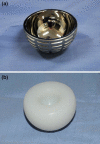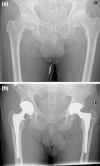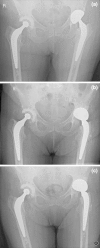Outcomes of dual-mobility acetabular cup for instability in primary and revision total hip arthroplasty
- PMID: 25330736
- PMCID: PMC4348500
- DOI: 10.1007/s10195-014-0324-9
Outcomes of dual-mobility acetabular cup for instability in primary and revision total hip arthroplasty
Abstract
Background: The concept of a dual-mobility hip socket involves the standard femoral head component encased in a larger polyethylene liner, which in turn articulates inside a metal shell implanted in the native acetabulum. The aim of this study was to assess outcomes from using a Serf Novae(®) Dual Mobility Acetabular cup (Orthodynamics Ltd, Gloucestershire, UK) to address the problem of instability in primary and revision total hip arthroplasty (THA).
Materials and methods: A retrospective review was carried out of all hip arthroplasties performed in a District General Hospital utilising the dual-mobility socket from January 2007 to December 2012. Clinical and radiological outcomes were analysed for 44 hips in 41 patients, comprising 20 primary and 24 revision THA. The average age of the study group was 70.8 years (range 56-84 years) for primary and 76.4 years (range 56-89 years) for revision arthroplasty. Among the primary THA, always performed for hip osteoarthritis or in presence of osteoarthritic changes, the reasons to choose a dual mobility cup were central nervous system problems such as Parkinson's disease, stroke, dementia (10), hip fracture (5), failed hip fracture fixation (2), severe fixed hip deformity (2) and diffuse peripheral neuropathy (1). The indications for revisions were recurrent dislocation (17), aseptic loosening with abductor deficiency (4), failed hemiarthroplasty with abductor deficiency (2) and neglected dislocation (1).
Results: At a mean follow-up of 22 months (range 6-63 months), none of the hips had any dislocation, instability or infection and no further surgical intervention was required. Radiological assessment showed that one uncemented socket in a revision arthroplasty performed for recurrent dislocation had changed position, but was stable in the new position. The patient did not have complications from this and did not need any surgical intervention.
Conclusions: Even though postoperative hip stability depends on several factors other than design-related ones, our study shows promising early results for reducing the risk of instability in this challenging group of patients undergoing primary and revision hip arthroplasty.
Level of evidence: IV.
Figures




References
-
- Hailer NP, Weiss RJ, Stark A, Kärrholm J. The risk of revision due to dislocation after total hip arthroplasty depends on surgical approach, femoral head size, sex, and primary diagnosis. An analysis of 78,098 operations in the Swedish Hip Arthroplasty Register. Acta Orthop. 2012;83(5):442–448. doi: 10.3109/17453674.2012.733919. - DOI - PMC - PubMed
-
- Adam P, Farizon F, Fessy MH. (2014) Dual mobility retentive acetabular liners and wear: surface analysis of 40 retrieved polyethylene implants. Orthop Traumatol Surg Res 18. doi: 10.1016/j.otsr.2013.12.011. [Epub ahead of print] - PubMed
MeSH terms
LinkOut - more resources
Full Text Sources
Other Literature Sources
Medical
Research Materials

